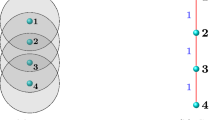Abstract
This paper addresses the leader selection problem for strong structural controllability (SSC) of multi-agent systems (MASs). For a path-bud graph, it is proved that only one leader is required to guarantee the SSC of MASs. For a special type of topologies, based on the partition of the topology into disjoint pathes and path-buds, it is proved that the MASs is strongly structurally controllable if the root nodes of the pathes are selected as leaders. For general topologies, an algorithm is provided to determine the agents that can behave as leaders. For some special topologies, the minimum number of leaders guaranteeing the robust strong structural controllability (RSSC) of MASs is also obtained. Two examples are given to verify the effectiveness of the results.
Similar content being viewed by others
References
Lin C T, Structural controllability, IEEE Transactions on Automatica Control, 1974, 19(3): 201–208.
Shields R W and Pearson J B, Structural controllability of multiinput linear systems, IEEE Transactions on Automatica Control, 1976, 21(2): 203–212.
Mayeda H and Yamada T, Strong structural controllability, SIAM Journal on Control and Optimization, 1979, 17(1): 123–138.
Bowden C, Holderbaum W, and Becerra V, Strong structural controllability and the multilink inverted pendulum, IEEE Transactions on Automatic Control, 2012, 57(11): 2891–2896.
Hartung C, Reissig G, and Svaricek F, Characterization of strong structural controllability of uncertain linear time-varying discrete-time systems, Proceedings of the 51st IEEE Conference on Decision and Control, Maui, Hawaii, USA, 2012, 2189–2194.
Hartung C, Reissig G, and Svaricek F, Sufficient conditions for strong structural controllability of uncertain linear time-varying systems, Proceedings of 2013 American Control Conference, Washington, DC, USA, 2013, 5875–5880.
Hartung C, Reissig G, and Svaricek F, Necessary conditions for structural and strong structural controllability of linear time-varying systems, Proceedings of 2013 European Control Conference, Zurich, Switzerland, 2013, 1335–1340.
Reissig G, Hartung C, and Svaricek F, Strong structural controllability and observability of linear time-varying systems, IEEE Transactions on Automatic Control, 2014, 59(11): 2087–3092.
Hou B Y, Li X, and Chen G R, Structural controllability of temporally switching networks, IEEE Transactions on Circuits and Systems-I: Regular Papers, 2016, 63(10): 1771–1781.
Jarczyk J C, Svaricek F, and Alt B, Strong structural controllability of linear systems revisited, Proceedings of the 50th IEEE Conference on Decision and Control, Orlando, FL, USA, 2011, 1213–1218.
Chapman A and Mesbahi M, On strong structural controllability of networked systems: A constrained matching approach, Proceedings of the 2013 American Control Conference, Washington, DC, USA, 2013, 6126–6131.
Tanner H, On the controllability of nearest neighbor interconnections, Proceedings of the 43rd IEEE Conference on Decision and Control, Atlantis, Paradise Island, Bahamas, 2004, 2467–2472.
Rahmani A and Mesbahi M, On the controlled agreement problem, Proceedings of the 2006 American Control Conference, Minneapolis, Minnesota, USA, 2006, 1376–1381.
Rahmani A and Mesbahi M, Pulling the strings on agreement: Anchoring, controllability and graph automorphisms, Proceedings of the 2007 American Control Conference, New York City, USA, 2007, 2738–2743.
Rahmani A, Ji M, Mesbahi M, et al., Controllability of multi-agent systems from a graph-theoretic perspective, SIAM Journal on Control and Optimization, 2009, 48(1): 162–186.
Martini S, Mesbahi M, and Rahmani A, Controllability analysis of multi-agent systems using relaxed equitable partitions, International Journal of Systems, Control and Communications, 2010, 2(1–3): 100–121.
Liu Y Y, Slotine J J, and Barabasi A L, Controllability of complex networks, Nature, 2011, 473(7346): 167–173.
Zamani M and Lin H, Structural controllability of multiagent systems, Proceedings of the 2009 American Control Conference, Hyatt Regency Riverfront, St. Louis, MO, USA, 2009, 5743–5748.
Pequito S, Preciado V, and George J P, Distributed leader selection, Proceedings of the 54th IEEE Conference on Decision and Control, Osaka, Japan, 2015, 962–967.
Jafari S, Ajorlou A, and Aghdam A G, Leader localization in multi-agent systems subject to failure: A graph-theoretic approach, Automatica, 2011, 47(8): 1744–1750.
Rahimian M A and Aghdam A G, Structural controllability of multi-agent networks: Robustness against simultaneous failures, Automatica, 2013, 49(11): 3149–3157.
Monshizadeh N, Zhang S, and Camlibel M K, Zero forcing sets and controllability of dynamical systems defined on graphs, IEEE Transactions on Automatic Control, 2014, 59(9): 2562–2567.
Liu P, Tian Y P, and Zhang Y, Strong Structural Controllability and Leader Selection for Multi-Agent Systems with Unidirectional Topology, Springer Berlin Heidelberg, 2016.
Ruths J and Ruths D, Control profiles of complex networks, Science, 2014, 343: 1373–1376.
Yu C B, Qin J H, and Gao H J, Cluster synchronization in directed networks of partial-state coupled linear systems under pinning control, Automatica, 2014, 50(9): 2341–2349.
Barioli F, Barrett W, Fallat S M, et al., Zero forcing parameters and minimum rank problems, Linear Algebra and Its Applications, 2010, 433(2): 401–411.
Cormen T H, Stein C, Rivest R L, et al., Introduction to Algorithms, McGraw-Hill Higher Education, New York, 2001.
Alon N, Fomin F V, Gutins G, et al., Spanning directed trees with many leaves, SIAM Journal on Discrete Mathematics, 2009, 23(1): 466–476.
Reinschke K, Multivariable Control: A Graph-Theoretic Approach, Springer-Verlag, New York, 1988.
Author information
Authors and Affiliations
Corresponding author
Additional information
This work was supported by the National Natural Science Foundation of China under Grant Nos. 61573105, 61473081, 61273110, and the Natural Science Foundation of Jiangsu Province under Grant No. BK20141341.
This paper was recommended for publication by Editor JIA Yingmin.
Rights and permissions
About this article
Cite this article
Liu, P., Tian, YP. & Zhang, Y. Leader selection for strong structural controllability of single-integrator multi-agent systems. J Syst Sci Complex 30, 1227–1241 (2017). https://doi.org/10.1007/s11424-017-6074-z
Received:
Revised:
Published:
Issue Date:
DOI: https://doi.org/10.1007/s11424-017-6074-z




